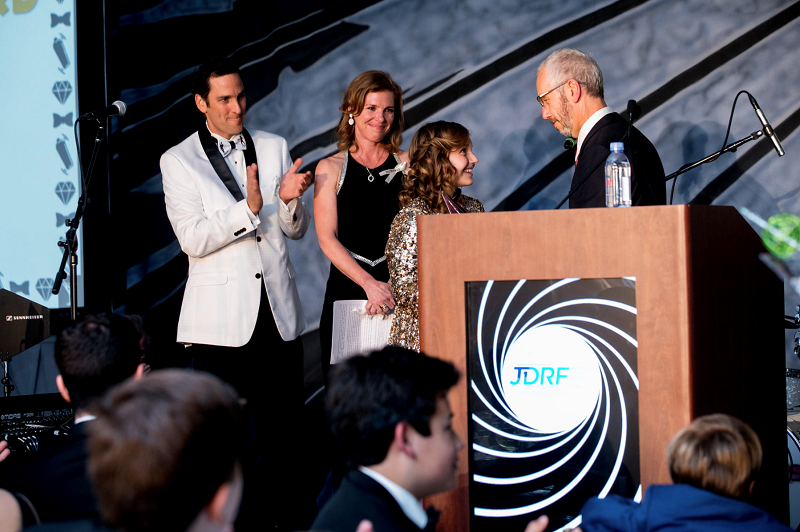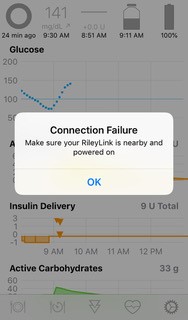Looping with Jamie – February 2019
After two years of sharing her experiences with the Medtronic 670G under the title “Diary of an Artificial Pancreas”, 14-year old Jamie Kurtzig has renamed her blog “Looping with Jamie”. In each entry, she will continue to write about her day-to-day experiences living with type 1 diabetes (T1D), now using the DIY app-based system that connects a continuous glucose monitor and an insulin pump to her phone to bring automated insulin adjustments.
February 2:
I am so excited to head down to Stanford’s Pixel Fest today to meet so many people from around the country and around the world! In addition to my regular “brick and mortar” school, I also take one class at Stanford Online High School where we meet online to take class. I have only gone to one other “meetup” this year, so I am excited to meet some new people. Last time I went to a meetup, I noticed that most of the students were basically geniuses and/or had an amazing extracurricular activity that did not fit with the schedule of a “regular” school. When I arrived, I listened to a student rap battle between “Odysseus” and “Polyphemus” – yes, they actually rapped about the Odyssey! That was one of the highlights of the day for me just because it is not everyday when I hear a rap about this. Next, I heard from an adult keynote speaker about robotics and its uses. I found it so interesting how she was working with robots that could do so many different things from putting out fires to doing surgery. I think this is fascinating and will definitely help the medical field a lot – it might even help with finding a cure for T1D one day.
After lunch, we split off into groups that we chose in advance. I chose to dissect a sheep brain. I had a great time dissecting the brain and even found the hippocampus (it stores memories). Then, we played Jeopardy – a very humbling experience for me. There was a student who looked much younger than I, and she got all of the Jeopardy questions correct. I only got one of them right. I felt so dumb afterwards. I had to keep reminding myself that maybe she was just fascinated with the brain and had an incredible memory. At first, I just dismissed this and thought she was a genius while I was dumb. But then, I thought about how I know an unusual amount about type one diabetes. I mean, not every 14 year old knows what a CGM is or what a basal rate modulator does or what fiasp is. So maybe, she or someone she loves is affected by something in the brain. This really taught me that I need to stop making snap judgements about people. It is super easy for people to do, but there can always be another possibility.
Here is a picture of me dissecting a sheep brain with another OHS student!
February 25-March 1:
This week, I am participating in a super fun activity called “Minicourse” that my high school offers. Students are able to choose from a variety of different activities from sailing to cooking to capoeira. I chose to do a service learning Minicourse where we help out at local public schools. It is so fun to help little kids! My favorite part so far has been helping lower level reading second graders with understanding a book they were reading. I tried to make this into a game of Jeopardy where they needed to tap a “buzzer” and say the right answer to the comprehension question I asked. It was so rewarding for me to see them enjoying reading! This week of service inspired me to spend even more time working with the JDRF to find a cure because service learning makes me feel so happy.
February:
I am learning a lot about looping recently! Lately, I have been having some difficulties with loop when it kicks me out (red circle). This is what I have been doing to try and get back in loop:
As you can see, this takes quite a while and is very frustrating (especially when I am about to go to bed). If you use loop, I hope this helps you with troubleshooting!
Here are some error messages I have received:
I am learning a lot about looping recently! Lately, I have been having some difficulties with loop when it kicks me out (red circle). This is what I have been doing to try and get back in loop:
- I tap on the red circle in the top left corner (it usually tells me what is wrong).
- If it says something about my Riley Link…
- I turn my Riley link off and on using a ballpoint pen.
- I tune the radio by going into loop, settings, “Minimed 523”, “RileyLink”, and “916.45 MHz” or “Tune Radio Frequency”. I wait until it comes up with something.
- Loop should turn back on. If it doesn’t, I go to loop, settings, “Minimed 523”, and turn RileyLink off and on. If this doesn’t work, then I refresh all of my apps and restart my phone.
- If the error message says something about my Dexcom readings…
- I go into my Dexcom app to see if it has a reading or not.
- If it doesn’t have a reading…
- I go to settings, bluetooth, and turn bluetooth off.
- I refresh all of my apps.
- I restart my phone.
- I turn bluetooth back on.
- I go into Dexcom to see if i am getting a reading, and I wait.
- If it does have a reading…
- I go to loop and then Dexcom share. I add the account and wait until I am looping (don’t forget to delete the account after you get back into loop!).
- If this doesn’t work, I do all the steps listed above because my Riley Link might need some troubleshooting.
- If it doesn’t have a reading…
- I go into my Dexcom app to see if it has a reading or not.
- If it says something else is wrong…
- I try to do all of the steps I listed above for both categories.
As you can see, this takes quite a while and is very frustrating (especially when I am about to go to bed). If you use loop, I hope this helps you with troubleshooting! If you have other tips, please share!
Here are some error messages I have received:
March 1:
I am so sad that today is my last day of Minicourse! I have had such an amazing time and am already looking forward to next year’s Minicourses. However, I have noticed that I have been running low this week. Today, I have gone low 3 times! This is super unusual for me – especially because I use the loop. I think I have eaten more glucose tabs this week than I have in 3 months. I was so curious why this was happening. Somehow, we figured out that I had been using Fiasp before this week and when I changed back to my normal insulin, we forgot to change my loop setting. This made me go low because Fiasp acts so much faster than the normal insulin. Whenever I ate something and bolused, loop thought that the insulin would work more quickly. When it didn’t, loop gave more insulin. All of the insulin from my earlier bolus and the extra basal made me go low. To change which insulin you are using, go to loop, settings, and insulin model. Please don’t make the same mistake I did!
On the graph, it looks like the difference between Fiasp and Rapid-Acting for Children is small, but it really changed how much I went low.
February 28:
As many of you may know, Dr. Adi (my doctor since I was diagnosed 13 years ago) is leaving UCSF. Today is my last doctor’s appointment with him. I am so grateful for him since he always supported my family and I from day one. Although I do not remember this, my mom told me a story of when I was diagnosed at age 1. My mom was frantic and had no idea what type one diabetes meant other than that it was a lifelong chronic disease without a cure. In the hospital, I was hooked up to many machines and doctors were helping me get my blood sugar down from 666. Dr. Adi came up to my parents and said, “She can live a full and happy life.” My mom has not forgotten this, and I will not either. From that day on, he has been there for us during the middle of the night when my numbers were out of control. He was there for us when I switched from shots to my first pump. He was even there for us when I was on my clinical trial. At the Hope Gala, he presented my parents and I with the 2018 Living and Giving Award and gave a speech for us. Throughout this roller coaster of high numbers and low numbers, good days and bad days, he has always supported us. Thank you, Dr. Adi for inspiring me to be interested in medicine. I would not be reading an article about editing stem cells with CRISPR to find a cure for T1D without you. I know that you are leaving UCSF, but I am sure you will move on to do more great things for the T1D community. Thank you again for helping my family and I these past 13 years!
 Dad, Mom, and me with Dr. Adi at the JDRF Hope Gala.
Dad, Mom, and me with Dr. Adi at the JDRF Hope Gala.
Aloha! Jamie

